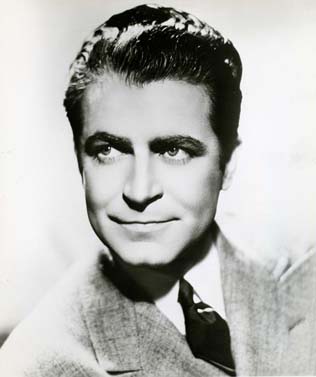
pay his own way, he found work singing and playing his saxophone in a restaurant.
After a booking agent offered him a job performing in New Orleans, Tucker decided to stick with music.
vital stats:
given name Orrin Tucker
birth February 17, 1911, St. Louis, MO
education grammar school, Wheaton, IL; graduate, Wheaton High School, Wheaton, IL, 1929;
School of Speech, Northwestern University, Evanston, IL; enrolled at North Central College,
Naperville, IL, 1932
military service Lieutenant, U.S. Navy, 1942-45
first wife Jill Powell, a model, m.Jan. 12, 1944, div.1952
second wife married ca.1975
hobby baseball
membership ASCAP, 1953-
residence South Pasadena, CA (1990s)
At first, Tucker’s band, organized in 1933, spent month after month on the road.
They had a long stay at the Troutdale Hotel in Evergreen, CO in 1935, but the most important breaks didn’t happen until a couple of others lent a helping hand.
Fellow bandleader Eddy Duchin heard them at the William Penn Hotel in Pittsburgh in early 1936, and recommended that they be hired to play the summer season at the Edgewater Beach Hotel in Chicago.
They returned in October 1937 and spent six more months there.
In February 1938, trumpet legend Louis Armstrong, then leading his own orchestra, called Tucker, suggesting that he hire a singer he’d just seen at the Claridge Hotel in St. Louis named Evelyn Nelson. Tucker did, and he promptly gave her the catchy stage name “Bonnie Baker.” (Since she was only 5 feet tall, he began introducing her as “’wee’ Bonnie Baker.”)
In November of that year, Tucker and his band opened an engagement at the Palmer House in Chicago.
“Tucker’s music is ideal for the Empire room,” it was stated in the Chicago Daily Tribune. “It is swing in a dress suit.”
Signed to Vocalion Records in 1938, they made mostly novelties, such as What Are Little Girls Made Of? and Billy, sung by Baker, along with ballads, including Wishing (Will Make It So) and Blue Orchids, with Tucker’s vocals.
When CBS bought Columbia Records in 1939, the band was bumped up to that label and continued with a similar repertoire, including Wouldja Mind?, You’d Be Surprised, and Apple Blossoms and Chapel Bells.
It was the song Oh Johnny, Oh Johnny, Oh!, featuring Baker, which catapulted them to fame. Recorded in Los Angeles on August 20, 1939, the disc stayed on the popularity charts in Billboard for 14 weeks.
When Tucker’s band returned to the Palmer House in January 1940, a reviewer in the Chicago Daily Tribune observed, “Miss Baker is a master of timing, that essential element of show business, and wisely confines her mischievous voice to such smile provoking tunes as ‘Johnnie’ [ sic ], ‘Stop, It’s Wonderful,’ ‘Billy,’ and ‘My Resistance Is Low.’”
She died in 1990 at the age of 72.
Among the others in Tucker’s band were, at various times, violinist George Liberace and vocalist Gil Mershon, who sang At the Balalaika. Comedian Jerry Colonna, who co-starred with Tucker and the band in a Paramount motion picture, “You’re the One,” recorded with them for Columbia one of the songs from the film’s soundtrack, The Yogi Who Lost His Will Power, on November 11, 1940.
Tucker entered military service in 1942 and, upon his release in late 1945, formed a new band.
A sampling of their itineraries from then into the mid-1950s included the Strand Theatre in New York City; the Trianon Ballroom and the Stevens Hotel in Chicago; Casino Gardens in Ocean Park, CA; and the Hotel Mark Hopkins in San Francisco.
Over the years, Tucker had acquired interests in the insurance, oil drilling, and radio broadcast industries, so he decided to disband, to better manage those investments.
In 1956 his former wife, Jill, sued him for more than a million dollars - four years after they were divorced - claiming that she only then had fully learned of his wealth. Identified among Tucker’s assets were eleven oil wells in Texas; a 7,000-acre oil field in Colorado; various real estate holdings including two apartment buildings in Berkeley, CA; and cash.
Tucker returned to bandleading a few years after that.
Orrin Tucker in His Own Words:
“I have no regrets choosing music over medicine . . . It’s proven to be a good choice for me.”
“I always thought that what the people want come first. There were so many musicians that
said regardless what the public wants I’ll play the way I want to play. I’ve always tried to play
the music people are fond of and play it the way they want to hear and the way it is easy to
dance to. I made it a point to know what the public liked and did my best to please them.”
“All my life I am a person who wanted to be in a position to help people . . . I believe that the
source of happiness is helping others.”
Tucker appeared as himself in a made-for-TV-movie, “Queen of the Stardust Ballroom,” which aired February 13, 1975 and cast Maureen Stapleton as a widow and Charles Durning as a postman who rediscover their youth while ballroom dancing.
That gave Tucker the idea to shortly afterwards buy an abandoned skating rink on Sunset Blvd. in Hollywood and convert it into a dance venue, which he named The Stardust Ballroom.
Naturally, his own band became its star attraction, with Tucker playing lots of “oldies-but-goodies” and adding in a few more recent songs like It’s Impossible, Tie a Yellow Ribbon Round the Ole Oak Tree, and Bad, Bad Leroy Brown to his playlist.
Just for fun, during the 1980 Presidential campaign, he wrote and recorded a political spoof, Tucker for President, making promises of what he would do if he were elected.
After Tucker concluded a long run at The Stardust Ballroom in 1982, he continued to occasionally lead a band, at Disneyland or Las Vegas or Lake Tahoe.
Away from the stand, he donated a lot of his time visiting southern California hospitals and health care centers, offering good cheer and talking about the glory days of the big bands.
Eventually, his own health problems forced him into retirement.
Still alive at this writing, Tucker is age 97 and apparently confined to a nursing home.
sources:
“Bonnie Baker and Tucker Top Empire’s Show,” Chicago Daily Tribune, Jan. 14, 1940,
p.C5.
Stephen Fratallone, “King Of The Stardust Ballroom: Orrin Tucker Renowned For Music
That Catered To Ballroom Dancers,” Jazz Connection Magazine /
jazzconnectionmag.com, May 2000.
Charles Garrod, Orrin Tucker and His Orchestra (Zephyrhills, FL: Joyce Record Club, 1992).
“Orrin Tucker Weds Model,” Hartford Courant, Jan. 13, 1944, p.10.
“Orrin Tucker’s Ex-Wife Sues for $1,057,500,” Los Angeles Times, Oct. 26, 1956, p.6.
“Orrin Tucker’s Music Is Swing in a Dress Suit,” Chicago Daily Tribune, Dec. 18, 1938, p.2E.
“The Story of Orrin Tucker,” Chicago Daily Tribune, Feb. 11, 1940, p.G4.
“Tucker, Orrin,” in The ASCAP Biographical Dictionary, Fourth Edition (New York City:
R.R. Bowker Company, 1980), p.512.
John Tumpak, “Sidebar: Orrin Tucker – Still Going Strong,” Dancing USA, Apr./May 2000,
pp.37-38.
Joel Whitburn, Pop Memories 1890-1954: The History of American Popular Music
(Menomonee Falls, WI: Record Research, Inc., 1986), pp.423-424.
I would like to expand this tribute with, if possible, a new interview of someone who was important to Orrin Tucker's life or career. Are you an alumnus of his band, a member of his family, or a collector who is knowledgeable about his accomplishments? Please contact me via e-mail
return to "Biographical Sketches" directory
go to Big Band Library homepage
The big bands are back
in a new and exciting way!
ORRIN TUCKER
"SO YOU'RE THE ONE"
by Music Librarian CHRISTOPHER POPA
October 2008
Besides leading an entertaining sweet band during the course of some 60 years, he had a lot of admirable accomplishments.
His goals started as a young boy, when he became fascinated with the saxophone after seeing a picture of one in the Sears Roebuck department store catalog. So he saved money from his paper route and bought the instrument, making payments until it was his.
He was a personable student, and was chosen vice-president of his high school graduating class.
Intending to pursue his education for a career in medicine as a general practitioner, he applied for and won a year’s college scholarship. When the scholarship was up, he transferred to another school and, to be able to

Orrin Tucker, ca.1941